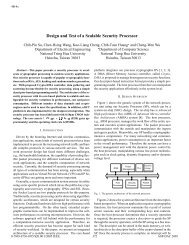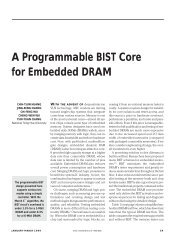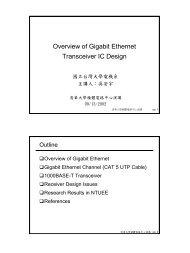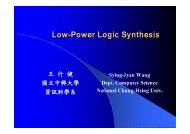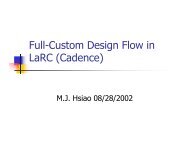A robust feedforward compensation scheme for multistage ...
A robust feedforward compensation scheme for multistage ...
A robust feedforward compensation scheme for multistage ...
You also want an ePaper? Increase the reach of your titles
YUMPU automatically turns print PDFs into web optimized ePapers that Google loves.
238 IEEE JOURNAL OF SOLID-STATE CIRCUITS, VOL. 38, NO. 2, FEBRUARY 2003<br />
Fig. 3.<br />
Block diagram of basic NCFF <strong>compensation</strong> <strong>scheme</strong> <strong>for</strong> two-stage amplifier.<br />
a Miller compensated amplifier, the dominant pole is pushed to<br />
lower frequencies due to the Miller effect (pole splitting), resulting<br />
in lower bandwidth structures. Also, a right-half-plane<br />
(RHP) zero is created which degrades the phase response. A<br />
nulling resistor is usually used to cancel the effect of the RHP<br />
zero. Other reported <strong>scheme</strong>s use the positive phase shift of a<br />
left-half-plane (LHP) zero created by a <strong>feed<strong>for</strong>ward</strong> path to improve<br />
the phase response [2], [4], but all of these still use Miller<br />
capacitors. Recently, active <strong>feed<strong>for</strong>ward</strong> techniques have been<br />
used <strong>for</strong> the design of <strong>multistage</strong> amplifiers. In [11], a theoretical<br />
analysis on the effects of <strong>feed<strong>for</strong>ward</strong> networks is presented, and<br />
in [12], the technique is used <strong>for</strong> the design of low-frequency instrumentation<br />
amplifiers.<br />
The <strong>compensation</strong> <strong>scheme</strong> used in this paper employs a <strong>feed<strong>for</strong>ward</strong><br />
path to create LHP zeros, but does not use any Miller<br />
capacitor. The dominant pole is not pushed to lower frequencies,<br />
resulting in a higher gain-bandwidth product with a fast<br />
step response. The proposed <strong>compensation</strong> <strong>scheme</strong> is described<br />
in Section II. The effects of pole–zero mismatch on the per<strong>for</strong>mance<br />
of the amplifier are discussed in Section III. It is shown<br />
that the proposed technique is <strong>robust</strong> even if the integrating and<br />
load capacitors are varied by more than a decade. Section IV<br />
describes the circuit implementation. The simulation and experimental<br />
results are discussed in Section V, and conclusions are<br />
drawn in Section VI.<br />
(a)<br />
(b)<br />
Fig. 4. Amplifier frequency response and pole–zero locations in open and<br />
closed loop. (a) Perfect pole–zero cancellation. (b) Pole–zero mismatch.<br />
II. NO-CAPACITOR FEEDFORWARD (NCFF) COMPENSATION<br />
SCHEME FOR MULTISTAGE AMPLIFIERS<br />
stages have a common pole at<br />
amplifier voltage gain is<br />
. The overall<br />
The proposed NCFF <strong>compensation</strong> <strong>scheme</strong> alleviates the<br />
drawbacks of Miller <strong>compensation</strong> <strong>scheme</strong>s. The block diagram<br />
of the NCFF <strong>scheme</strong> is shown in Fig. 3. The <strong>compensation</strong><br />
<strong>scheme</strong> uses the positive phase shift of LHP zeros, created by<br />
a <strong>feed<strong>for</strong>ward</strong> path, to compensate the negative phase shift due<br />
to the poles. The pole–zero pair is created at high frequencies<br />
to avoid slow settling components associated with pole–zero<br />
cancellation at low frequencies [8]. The main concept can be<br />
explained by assuming a single-pole response <strong>for</strong> the three<br />
blocks. , , and are the dc gains of the first, second,<br />
and <strong>feed<strong>for</strong>ward</strong> stages of the amplifier. The pole of the first<br />
stage is located at<br />
and the second and third<br />
The OTA transfer function has two poles and a LHP zero created<br />
by the <strong>feed<strong>for</strong>ward</strong> path. The dc gain is given by<br />
(3)





